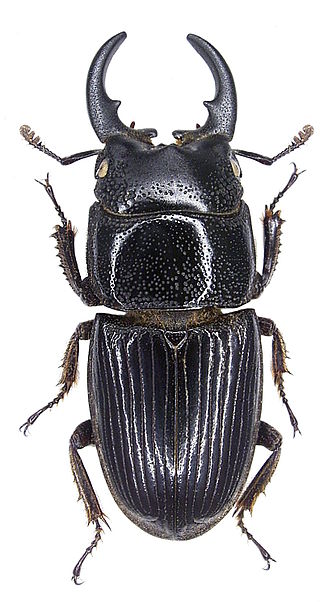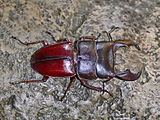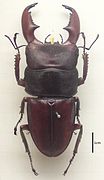
Harmonia is a genus of lady beetles belonging to the subfamily Coccinellinae.

Prosopocoilus giraffa, the giraffe stag beetle, is the world's largest stag beetle and is a member of the family Lucanidae within the order Coleoptera. They have very long, toothed and notched mandibles that protrude about half the size of their body. They tend to be aggressive and are fierce and powerful. Males fight each other using these strong and enlarged jaws to lift and throw rivals to win a mate. They can grow up to 119 millimetres in length. Several distinctive populations (subspecies) are found in moist forested region areas of Asia, ranging from India to Indonesia. Prosopocoilus giraffa keisukei can measure up to 12 centimeters. Prosopocoilus giraffa daisukei have the brightest elytra of all subspecies and Prosopocoilus giraffa giraffa is the smallest subspecies.

Insect fighting is a range of competitive sporting activity, commonly associated with gambling, in which insects are pitted against each other.

The warbling white-eye is a small passerine bird in the white-eye family. The specific epithet is occasionally written japonica, but this is incorrect due to the gender of the genus. Its native range includes much of East Asia, including the Russian Far East, Japan, Indonesia, Korea, and the Philippines. It has been intentionally introduced to other parts of the world as a pet and as pest control, with mixed results. As one of the native species of the Japanese islands, it has been depicted in Japanese art on numerous occasions, and historically was kept as a cage bird.

Dorcus is a genus of beetles in the stag beetle family Lucanidae. Of the over 100 species, most occur in Asia and India; two are found in southern Europe, and two species are from North America. Previously, specimens with serriform teeth on the mandibles and sable pigment were called Serrognathus whereas specimens with but a singular or multiple bulky notches on the mandibles and lustrous sable pigmentation were called Dorcus.

Lucanus cervus, known as the European stag beetle, or the greater stag beetle, is one of the best-known species of stag beetle in Western Europe, and is the eponymous example of the genus. L. cervus is listed as Near Threatened by the IUCN Red List.

Odontolabis cuvera, the golden stag beetle, is a beetle of the family Lucanidae, stag beetles.

The Ryukyu flying fox or Ryukyu fruit bat is a species of megabat in the family Pteropodidae. It is found in Japan, Taiwan, and the Batanes and Babuyan Islands of the Philippines. Its natural habitats are subtropical or tropical dry forests and subtropical or tropical swamps. It is threatened by habitat loss and by hunting for food and the IUCN classify it as "Vulnerable".
The Lucanidae are a family of beetles that include the stag beetles. The family can be further subdivided in a taxonomy. The classification presented here follows Smith (2006), with the exception of the tribal classification within the Lucaninae.

Batocera is a genus of the family Cerambycidae, subfamily Lamiinae, close to the genus Rosenbergia.

Serrognathus is a genus of beetles in the stag beetle family Lucanidae. Species of the genus are found in the Indo-Australian region.

Cyclommatus is a genus of the family Lucanidae, also known as the stag beetle. The majority of the species from the genus Cyclommatus are located in Southeast Asia, though some species are found in China and Taiwan as well. The genus Cyclommatus also consists of three subgenera: Cyclommatus, Cyclommatinus and Cyclommatellus. Each subgenera contains 80, 24 and 3 species respectively. In total, the genus Cyclommatus consists of a total of 134 species, though more are still being discovered to this day.

Odontolabis is a genus of beetles belonging to the family Lucanidae.

Geodorcus helmsi, known as New Zealand giant stag beetle or Helms's stag beetle, is a large, slow-moving, flightless stag beetle in the family Lucanidae. It is endemic to New Zealand.

Pristionchus is a genus of nematodes (roundworms) in the family Diplogastridae that currently includes more than 50 described species. They are known mainly as non-parasitic associates of insects, especially beetles, while others have been reported from soil, organic matter, or rotting wood. The genus includes P. pacificus, a satellite model organism to the well-studied nematode Caenorhabditis elegans.

Prosopocoilus buddha is a species of stag beetle in the tribe Cladognathini. This Asian species is variable, with several known subspecies and widely distributed from India to Sulawesi.

Aegus chelifer, is a species of stag beetle found in Indo-Malaya regional countries.

Aegus is a genus of stag beetles in the family Lucanidae. Comprising about 260 species in the genus, they are placed in the largest subfamily Lucaninae. They are distributed in South Asia, Southeast Asia and the Pacific countries, but introduced accidentally to many parts of the islands.

Dorcus hopei is a beetle in the family Lucanidae.























